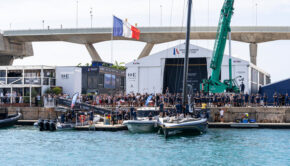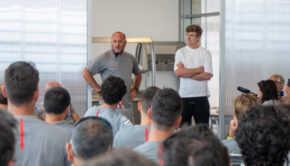Why I will watch the America’s Cup, Sadly
Published on January 13th, 2017
by David Salter
Like millions of sailing enthusiasts around the world, I will be watching the America’s Cup racing on television, not because I admire the current version of this great event, but because my 50-year allegiance to the sport demands it.
The fundamental notion of there being a pinnacle of international yachting competition is what will always attract the loyalty of the true enthusiast.
But to my mind, the essential problem for the 35th America’s Cup is that it is not being sailed in boats. Like the previous challenge, it is a contest between two-hulled, one-winged, low-flying aircraft. The AC catamarans have no significant displacement. The design of their hulls is largely an irrelevance. The so-called “sail” is a highly fragile and complex contraption that owes more to aerospace research than the skills of any loft.
While all of that technology is certainly impressive, it bears little relation to the type of sailing the vast majority of us enjoy. We don’t toddle out to the starting line in crash helmets and survival suits. Nor do we rely on sophisticated computing power to choose our gybe angles or select the optimum angle of heel.
Even the intensely hi-tech world of Formula One manages to retain some connection to the ordinary motorist. The F1 cars have a wheel at each corner and an engine somewhere in the middle. They are, in other words, still cars. But the AC foilers are nothing like the average dinghy or yacht that most of us sail.
And we like to devote two or three hours to a good, solid race, not a frantic wham-bam-thank-you-ma’m sprint that’s all over inside 30 minutes because that’s the kind of instant gratification the short attention span TV executives want. The America’s Cup has let itself become just another commercialized spectacle, with all the grubbiness that inevitably infects sport when the dollars begin to outweigh the merits of the contest itself.
So, yes, I’ll be watching the racing, but all the time I’ll be wishing it was more like those wonderfully elegant contests we had 30 years ago between the 12-metres. Back then, every sailor in the world could follow the tactics and imagine themselves on board the yachts. It was engrossing – the very best our sport could offer.
I doubt the Battle in Bermuda will generate that same feeling.
Editor’s note: The author, David Salter, asked that we add this follow-up (on Jan. 15) to this report above:
It is heartening to read so many comments from Scuttlebutt readers to my short article on the America’s Cup. Sensible debate should always be welcomed. Everyone is entitled to their opinion, but many of the responses are based on a complete misrepresentation of my position, and make silly assumptions.
First up, let’s get rid of the predictable smear that I must be some blue-blazered old buffoon propping up the bar in an establishment yacht club. I’m an active sailor who’s raced everything from 12-foot skiffs to 100-foot supermaxis, and still do.
The editor asked for specific views on the coming America’s Cup series. That’s what I offered. It is nonsense to assume, as so many have done, that I am opposed to multi-hulls, foils or anything else that brings progress to our sport.
The America’s Cup, however, is different. It has a unique and continuous history stretching back to 1851. My affection for the event is framed by a knowledge of what it has contributed to sailing over those 166 years. Within that context, I believe it needs to be contested in a form that has a direct relationship to the more conventional types of racing the majority of us enjoy.
Crucially, the AC is a match-racing series. Sheer speed – as much as it may be exciting to watch – is largely irrelevant. In the challenges where one boat had a clear performance advantage – for example Columbia v Sceptre (1958) or Oracle v Alinghi (2010) – the racing was dull.
But when the yachts are evenly matched, even very “slow” races can be utterly gripping.
I suspect that those commentators who dismiss contests between displacement yachts as axiomatically “boring” are too young to have witnessed Race 7 of Liberty v Australia II (1983). Millions of Australians stayed up until 3:00am to watch live coverage on two TV networks.
The yachts were never moving at more than 5 or 6 knots but that 4-hour contest was memorably exciting. There was a similarly heart-stopping slow motion finish in Valencia in 2007.
To me it is the contest of sailing skill that makes the America’s Cup special, not the speed.
Background: The 35th American’s Cup has attracted six teams (5 challengers and 1 defender) that will compete in the new 15-meter AC Class, with a series of qualifiers beginning on May 26, 2017 that lead to the start of the America’s Cup Match on June 17, 2017. Complete schedule.








 We’ll keep your information safe.
We’ll keep your information safe.